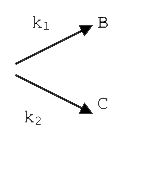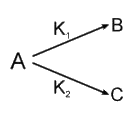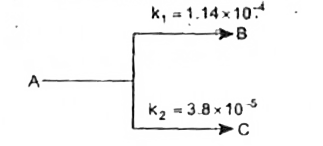Decomposition of A follows two parallel 1st order reactions with and . Find % distribution of the products.Solution in Odia
Step by step video & image solution for Decomposition of A follows two parallel 1st order reactions with K_1=1.3xx10^-4 sec^-1 and K_2=3.9 xx10^-5 sec^-1. Find % distribution of the products. by Chemistry experts to help you in doubts & scoring excellent marks in Class 12 exams.
Updated on:21/07/2023Topper's Solved these Questions
- ALDEHYDES,KETONES,MONOCARBOXYLIC ACIDS BOOK - USHA PUBLICATIONCHAPTER - ALDEHYDES,KETONES,MONOCARBOXYLIC ACIDS EXERCISE - EXERCISE
230 Videos
- D- AND F_BLOCK ELEMENT & CO-ORDINATION COMPOUND BOOK - USHA PUBLICATIONCHAPTER - D- AND F_BLOCK ELEMENT & CO-ORDINATION COMPOUND EXERCISE - EXERCISE
281 Videos
Similar Questions
Arrange the following in decreasing order of Tenctivity towards nucleophillic addition. (A)CH3−CO−CH3, (B)CH3−CHO, (C)H−CHO
View SolutionWhich of the following alloys does not contain copper?
View SolutionA substance undergoes first order decomposition. The decomposition follows two parallel first order reaction as: and KP_(1)=1.26xx10^(-4)sec^(-1) K_(2)=3.80xx10^(-5)sec^(-1) The percentage distribution of B and C are:
View SolutionThe substance undergoes first order decomposition.The decomposition follows two parallel first order reactons as : K_1=10^(-2) sec^(-1) and K_2=10^(-2)sec^(-1) If the corresponding activation energies of parallel reaction are 100 and 120 kJ "mol"^(-1) then the net activation energy of A is/are:
View SolutionA substance undergoes first order decomposition. The decomposition follows two parallel first order reactions as :
k1=1.26×10−4s−1,k2=3.8×10−5s−1
The percentage distribution of B and C are :

View SolutionThe substance undergoes first order decomposition. The decomposition follows two parallel first order reactions as : K_(1)=1.26xx10^(-4) sec^(-1) and K_(2) =3.8xx10^(-5) sec^(-1) The percentage distribution of B and C
View SolutionA substance undergoes first order decomposition. The decomposition follows two parallel first order reactions as The % distribution of B and C is ................ and .................. respectively.
View SolutionA substance undergoes first order decomposition. The decomposition follows two parallel first order reactions as , k_(1)=1.26xx10^(-4)" sec"^(-1) and k_(2)=3.6xx10^(-5)" sec"^(-1) Calculate the % distribution of B & C.
View SolutionThe substance undergoes first order decomposition. The decomposition follows two parallel first order reactions as :

K1=1.26×10−4sec−1andK2=3.8×10−5sec−1 The percentage distribution of B and C
View SolutionA substance undergoes a first order decomposition. The decomposition follows two parallel first order reactions as

The percentage distribution of B and C are
View SolutionThe specific reaction rates of a chemical reaction are 2.45xx10^(-5)sec^(-1)" at "273K and 16.2 xx10^(-4) sec^(-1) at 303 K. Calculate the activation energy.
View SolutionThe specific reaction rates of a chemical reaction are 2.45xx10^(-5)sec^(-1)" at "273K and 16.2 xx10^(-4) sec^(-1) at 303 K. Calculate the activation energy.
View SolutionA substance undergoes first order decomposition. The decomposition follows two parallel first order reactios as: and K_(1)=1.26xx10^(-4)"sec"^(-1),K_(2)=3.80xx10^(-5)"sec"^(-1) The percentage distribution of B and C are
View SolutionA to B , K_1= 0.693 sec^(-1) C to D, K_2 = 0.693 "min"^(-1) If t_1 and t_2 are half lives of two reactions, then
View SolutionThe substance undergoes first order decomposition.The decomposition follows two parallel first order reactons as : K_1=10^(-2) sec^(-1) and K_2=4 * 10^(-2)sec^(-1) If the corresponding activation energies of parallel reaction are 100 and 120 kJ "mol"^(-1) then the net activation energy of A is/are:
View Solution
